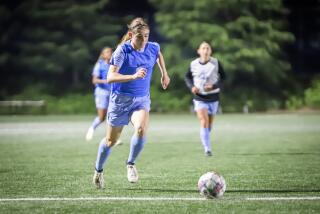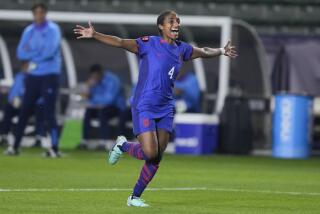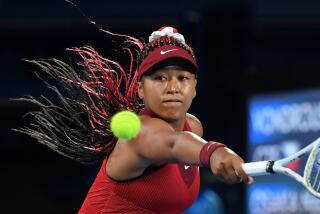COMMENTARY : When It Comes to Tennis Prodigies, the Ball Is in the Parents’ Court
- Share via
Fifteen-year-old Jennifer Capriati. ... All the references begin the same way: Fifteen-year-old Jennifer Capriati. Today’s story goes on to say that she beat Martina Navratilova. Tomorrow’s will talk about Gabriela Sabatini. The next day, it’ll be Steffi Graf. Everything after the first reference will be about tennis, which is what Jennifer Capriati does. But the first reference always starts with 15, which is what Jennifer Capriati is.
This is not about the tennis.
This is about the 15.
I don’t know where Jennifer Capriati is headed. I hope she becomes the best woman tennis player in the world. I also fear for her future.
The recent history of young girls in tennis is not a comforting one. Tracy Austin announced herself at 14. By 16, she’d won the U.S. Open. By 18, she was No. 1 in the world. Shortly thereafter, her body broke down. For all intents and purposes she was out of the game by 21. Andrea Jaeger, another wunderkind, didn’t climb quite as high as Austin, but fell as hard. When she was 17, Jaeger was No. 3. Then, her body started falling apart, and by the time she was 19 she was gone. Andrea Temesvari and Carling Bassett can recite similar tales of bruised bones and battered psyches. (Boys burn out and break down too, but boys never make such an impact at 15 or 16).
Steffi Graf’s body hasn’t peeled apart yet, but her spirit has. Graf may be the unhappiest 21-year-old woman in the world, thanks to her father’s miserable behavior. Steffi, whose father sawed off a racket handle so she could practice at 4, turned pro at 13, won the French at 17 and everything else at 19. Now she talks wistfully about retiring.
Seventeen-year-old Monica Seles, currently the No. 1 woman tennis player, went AWOL a few days before Wimbledon, offering neither a reason nor a forwarding address. Nobody knows quite what’s wrong with her. But she must think it’s calamitous. Why else would she blow off the world’s most prestigious tournament and go hide? The tabloids are chirping that Seles is pregnant. More conservative newspapers are guessing she’s injured. Meanwhile, there’s a report Seles is staying at Donald Trump’s Palm Beach estate. If she was my 17-year-old daughter, I wouldn’t want her within 5,000 miles of Donald Trump.
The pro tour turned out better for Chris Evert and Martina Navratilova. Both came through the star wars intact -- healthy, secure, dignified women (true, it took Navratilova into her mid-20s to sustain an even keel emotionally). But neither became pros as moppets. They did some growing up first. Evert finished high school, going to class with girls her own age, not faxing her homework in from another continent. Where does a 15-year-old girl turn for peers on the tour? Whom does she go to the mall with? Whom does she have a slumber party with? Parents can chaperone their children, but they can’t substitute for friends their children’s age.
We’ve had this debate at our house, whether the parents of a prodigy owe it to the world to let nothing stand in the way of the development of a monumental talent -- not school, not friends, not the endearing, goofy, necessary stumbles of childhood. I used to take the position that if my child were supremely gifted, I’d nurture and encourage the gift, admitting the risk of perverting the so-called “normal childhood.” But that was easy to say; I could argue the position hypothetically, because my kids weren’t playing Chopin or slamming backhand winners at 6. If it were a real-life call now, I wouldn’t send my kid to live with a Nick Bollitieri or a Bela Karolyi. I wouldn’t give her up that young. I wouldn’t make her into a lab rat.
I trust Jennifer Capriati’s parents have struggled with this issue. I trust they have doubts whether they’ve endangered their daughter’s emotional -- and physical -- development by rushing her into this alien, adult world. Fifteen is a confusing age. Girls are caught between the secure, stuffed animals of youth and the blossoming of adulthood. They’re groping to find a comfortable identity, something uniquely theirs, but not so far out that they can’t fit in a group. They do almost everything in groups at 15: shopping, movies, dating. In a sense, real life begins around 14, 15 and 16. How real is it to make $5 million in endorsements, and have hundreds of adults lined up, clamoring for your autograph at 15? How real is it to compete against people twice your age, and beat them? How real is it to major in room service? The other day Jimmy Connors said he was relieved his 12-year-old son Brett doesn’t want to become a professional tennis player. “In my heart I don’t want him to do it,” Connors said. “This is not a normal life.”
Parents can justify themselves by saying their child adores what she’s doing, and she’d do it endlessly anyway, even if there weren’t an organized tour to join. Sure she loves it. Who wouldn’t love success? Who wouldn’t love glamor and fame? But does she love it because it’s all she knows? Or maybe because she sees intuitively that it’s the surest way to please her parents, and at 15 what could be more gratifying than that? Tennis parents (and Little League fathers and stage mothers, etc.) have to acknowledge they gave their kids the earliest push. And they have to be able to answer the single toughest question: If there were no money in this, would they have pushed as hard?
So far, fifteen-year-old Jennifer Capriati seems to be doing just fine. In all ways other than tennis she is, thankfully, an unremarkable girl -- a giggler, a rock ‘n’ roller, same as you’d find in any mall. In Paris, she went to visit Notre Dame assuming it was a football field. When she was asked about Napolean, she referred to him as “that little dead dude?” That’s vintage 15, all sass and bubbles. I wish her good luck. I just hope that when she’s 21, none of the Capriatis are sorry for the choices they made.
More to Read
Go beyond the scoreboard
Get the latest on L.A.'s teams in the daily Sports Report newsletter.
You may occasionally receive promotional content from the Los Angeles Times.










